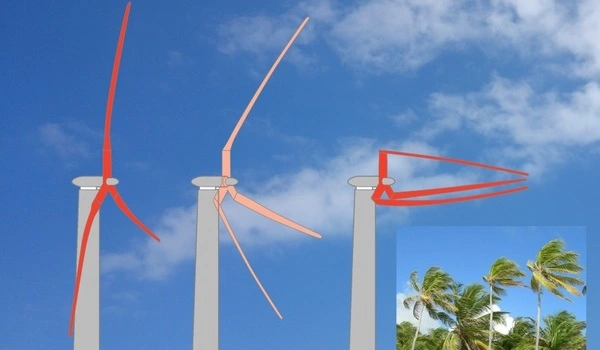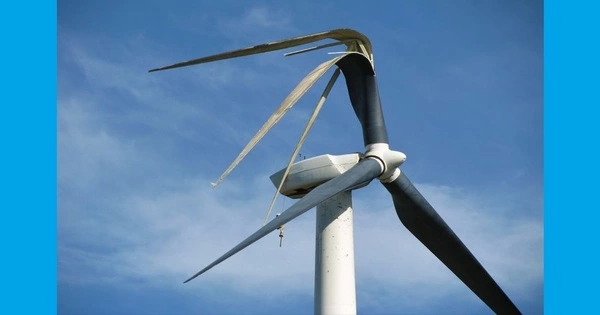In a world where hurricanes are intensifying and there is a greater demand for renewable energy, new results from real-world tests of a downwind turbine could inform and improve the wind energy industry. Wind technology is expanding, literally. Offshore wind turbines can now stand more than 490 feet above ground, with spinning blades producing up to 8 megawatts (MW) each – roughly enough to power 4000 homes in the United States.
However, as they grow in size, they face new challenges. Off the east coast of the United States, where offshore wind turbines are located, increasingly powerful Atlantic hurricanes pose risks to the structures and the future of wind energy. To make those turbines more hurricane-resilient, a team of CU Boulder researchers are taking a cue from nature and turning the turbine around.
“We are very much bio-inspired by palm trees, which can survive these hurricane conditions,” said Lucy Pao, Palmer Endowed Chair in the Department of Electrical, Computer and Energy Engineering.
Traditional upwind turbines face the incoming wind, and their blades must be sufficiently stiff to avoid being blown into the tower. The cost of these relatively thick and massive blades is driven up by the amount of material required to construct them. Downwind rotor turbine blades, on the other hand, face away from the wind, reducing the risk of them colliding with the tower when the winds pick up. This allows them to be lighter and more flexible, requiring less material and thus less money to manufacture. In the face of strong winds, these downwind blades can bend rather than break, similar to palm trees.
Over the past six years, in conjunction with collaborators at the University of Virginia, the University of Texas at Dallas, the Colorado School of Mines, and the National Renewable Energy Laboratory, Pao’s team has collaborated to develop the SUMR (Segmented Ultralight Morphing Rotor) turbine, a two-bladed, downwind rotor to test the performance of this lightweight concept in action. On June 10 at the American Control Conference, the CU researchers presented results from a new study of four years of real-world data from testing their 53.38 kilowatt demonstrator (SUMR-D) at the National Renewable Energy Laboratory’s (NREL) Flatirons Campus, just south of Boulder, Colorado.
We are very much bio-inspired by palm trees, which can survive these hurricane conditions. Traditional upwind turbines face the incoming wind, and their blades must be sufficiently stiff to avoid being blown into the tower.
Lucy Pao
They found that their turbine performed consistently and efficiently during periods of peak wind gusts — a satisfactory result.
“The blades are designed to be lightweight and flexible in order to align with wind loads. This way, we can reduce the cost of the blades while also lowering the cost of energy” Mandar Phadnis, a graduate student in electrical, computer, and energy engineering and the study’s lead author in Proceedings of the 2022 American Control Conference.
This creative work could not have come at a better time. Climate change not only necessitates the rapid deployment of more cost-effective and reliable renewable energy, but rising global temperatures are also likely to exacerbate hurricanes.
Hurricane activity this year in the Atlantic is predicted to be above average, with NOAA’s Climate Prediction Center estimating up to six major hurricanes with winds of 111 mph or higher from June 1 to November 30.
The hidden brain of a turbine
One of the most difficult aspects of wind energy generation is dealing with insufficient or excessive wind at the same time. A turbine cannot produce useful energy when wind speeds are too low. When gusts are too strong, they can exceed a turbine’s capacity, forcing it to shut down to avoid a system overload.
Wind speed inconsistency has plagued wind energy since its inception; the time lost shutting down the system results in less energy generated and less efficient production. Improvements to the controller, the part of the turbine that determines when to be more or less aggressive in power production, are critical to Pao’s innovative contributions.
“We like to think of the controller as essentially the brain of the system,” said Pao, senior author on the study and fellow at the Renewable and Sustainable Energy Institute (RASEI). This hidden brain aims to produce efficient wind energy at low cost and with low wear and tear. The feedback controller does this by using measurements of how the system is performing, and then adjusting to better improve the performance, said Pao.

The yaw controller ensures that the turbine is pointing in the right direction, the blade pitch controller determines the direction of the blades (based on wind speeds), and the generator torque controller determines how much power to pull from the turbine and onto the grid. While these controllers control physical components of the turbine, they are essentially software algorithms that tell the motors what to do.
Pao’s group is not only turning the turbine around to reduce damage from high winds, but it is also working behind the scenes on software to maximize the system’s ability to continue operating during peak wind events. “Our work attempts to predict the likelihood or probability of peak wind gusts occurring and then attempts to mitigate the speed peaks by acting before they occur,” Phadnis explained.
The Flatirons Campus at NREL was the ideal location for testing this, as it is strategically located to receive the strong winds that shoot out across Highway 93 and onto the mesa after being funneled directly to the west through Eldorado Canyon. There, the researchers found that, even through extensive experimental testing, peak generator speeds were below the threshold for their operational controller to keep the turbine running.
In a separate collaboration, Pao and her research group have been working with the University of Oldenburg in Germany to assess the utility of sensors that scan ahead of the turbine to measure the wind coming in and of advanced controllers that command the turbine to respond proactively.
Scaling up world wind energy
While downwind or two-bladed turbines like the SUMR-D may not come to dominate the wind energy industry, the researchers can better understand what is possible by conducting these multi-year, real-world tests, according to Pao.
The control algorithms they’ve developed may also be applicable to traditional three-bladed upwind turbines, which continue to dominate both land and offshore markets. “The advantage of the downwind configuration, however, really comes into play when you get to extreme scale turbines, which are primarily for offshore,” Pao explained.
Pao’s group is already addressing these lofty goals: They designed and modeled (but did not test) large-scale offshore 25 MW and 50 MW SUMR (downwind) turbines with their collaborators.
Finally, she believes that a combination of improved controllers, lighter and more resilient materials, and strategic turbine configurations will enable giant offshore turbines to outperform the competition. They are not only more cost-effective and energy efficient, allowing for one large turbine instead of many smaller ones (reducing installation and maintenance costs) and capturing faster wind speeds higher off the ground, but they may also be able to withstand the more severe weather that is unavoidable.
“Wind turbine blades are typically designed to last at least 20 years, and we want our novel concept blades to achieve similarly long lifetimes,” said Pao.





